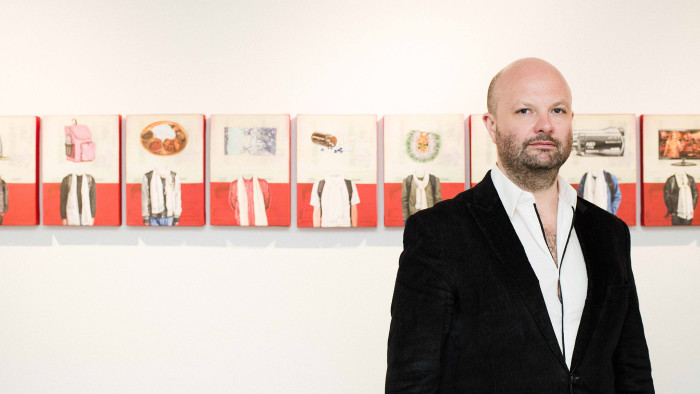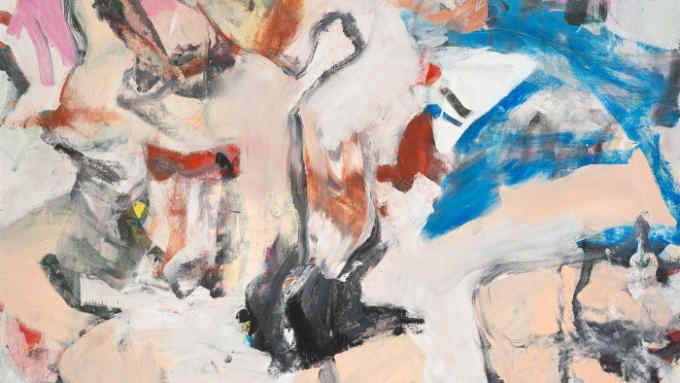Magnus Renfrew on launching an art fair in Taiwan

Simply sign up to the Life & Arts myFT Digest -- delivered directly to your inbox.
Magnus Renfrew loves a challenge. As a student, he persuaded the art history department at the University of St Andrews in Scotland to mark him on an exhibition instead of a written dissertation for the first time in the university’s history and ended up getting full marks. In 2006, the celebrated Shanghai-based gallerist Pearl Lam offered him a job after meeting him at an auction in London. Renfrew accepted, practically on the spot, and moved to China without knowing a word of Mandarin. When the Affordable Art Fair tried to recruit him to set up a new fair in Hong Kong in 2008, he said, “No, thank you — unless you make it a high-end affair.” They conceded and Renfrew created ART HK, the fair eventually acquired by Art Basel to become Art Basel Hong Kong, the undisputed leader among Asian art fairs, thanks in part to Renfrew’s original stewardship.
After leaving Art Basel in 2014, he had a brief hiatus from the world of art fairs — which included a stint as Bonhams’ deputy chairman in Asia and the publication of a book about the Hong Kong art scene — but has just announced the launch of a new regional fair based in Taiwan called Taipei Dangdai. Dovetailing with its sponsorship of Art Basel Hong Kong since 2013, UBS will be the new fair’s lead sponsor.
Due to take place in January 2019, Taipei Dangdai literally translates as “Taipei The Present Moment”, but the fair will not have an English name. “The idea was to avoid westernising a model,” Renfrew says. “We wanted to create something with specificity so that there’s a reason to go to it.”
He hopes that the “vast majority” of artists and galleries will come from Asia, but recognises that “local collectors will want to see galleries of sufficient global acclaim. The participation of big western galleries will give them the sense that this fair is different from what has gone before and that it’s international.”
By giving the fair a distinctly regional flavour, Renfrew hopes to sidestep comparison with Art Basel; the last thing he wants is “to be a not-so-good version of Art Basel, the gold standard”. He has not compromised on the quality of the Taipei selection committee, which includes the French art dealer Edouard Malingue, Patricia Crockett of Sprueth Magers and Elisa Uematsu of Taka Ishii.
“Just because most galleries around the world cannot participate in the eight or nine biggest global fairs [Art Basel, Tefaf, Frieze and Fiac in all their versions], doesn’t mean there’s no room for improvement at a regional level,” says Renfrew. Quality control makes or breaks a fair and can affect the growth of a regional gallery scene. At ART HK, Renfrew made participation in the fair “contingent on selection by an international committee based on qualitative grounds . . . which provided collectors a comfort level for buying from those galleries. That can really encourage new collectors to come through and expand the possibilities for regional galleries by raising their profile and providing a credible environment for sales.”
Sometimes, the existing art fair scene in a country does not reflect the potential for that market. Taiwan is exactly such a case, with one of the most developed gallery and collector bases in Asia.
“A lot of galleries have clients there and see the potential but there’s no good context, within Taiwan itself, for exhibiting,” says Renfrew. “The current fair is organised by the art gallery association, which is a democratic rather than meritocratic association.”
Local Asian galleries competing with big auction houses and hard-pressed to participate in the big fairs will no doubt welcome Taipei Dangdai. Their hope is that it begins a virtuous feedback loop between collectors and the local art industry. The seal of approval conferred by a stringent admission process encourages sales, which in turn incentivise investment in quality exhibitions and curation at commercial galleries.
Most importantly though, any new high-quality art fair goes some way to solving a major problem for galleries: meeting new clients. Long gone are the days when collectors would spend their weekends browsing art galleries. Instead, the one-stop-shop format of the art fair has become a commercial necessity — even a lifeline.
“Finding new collectors is the holy grail of art galleries,” quips the broadcaster Philip Dodd, who is chairman of the cultural agency Made in China and a stalwart of the Asian art world. Well-known international galleries, as well as smaller local outfits, can reap rewards when they invest in regional activity. Sadie Coles, who has exhibited at Shanghai’s West Bund fair for the past three years and intends to participate in this April’s inaugural Art Chengdu fair, observes that, besides attracting local collectors who may not go to the big international fairs, regional fairs encourage “visitors and galleries to really focus. It is boutique versus department store. We have more time to spend with the curators, collectors and museum groups who stop by, sometimes leading to collaborations which can last weeks, months or even years.”
Regional art fairs can also catalyse interest in art among the general public. In Hong Kong, with its comparatively under-developed public and non-profit art sector, ART HK and Art Basel have helped to develop the public appetite for art. While some decry the naked commercialism and mainstream wares of some of the Asian art fairs, Dodd points out that, “Art fairs are crucial if you want to develop art infrastructure outside the great metropolitan centres.”
Recognising that it’s not just about sales but increasing engagement, Renfrew has given Taipei Dangdai the subheading, “Art & Ideas”. “The art world is often navel-gazing and self-referential. I want to create a reconnection between art and the real world,” he says. “So often, people feel that the art world is a closed shop. But art is often dealing with common human values and challenges. Thus, we are inviting experts and speakers from different fields, like blockchain and AI, to speak and participate in the fair, to connect the dots with life outside the art world.”
Regional fairs such as Taipei Dangdai also counteract the homogenisation of art world culture. “I don’t want Frieze and Art Basel to become the Google of the art world,” Dodd says. “Regional art fairs are a bulwark against the domination of big art fair enterprises imposing their identity across the world.”
facebook.com/taipeidangdaiartfair
Follow @FTLifeArts on Twitter to find out about our latest stories first. Subscribe to FT Life on YouTube for the latest FT Weekend videos

Comments